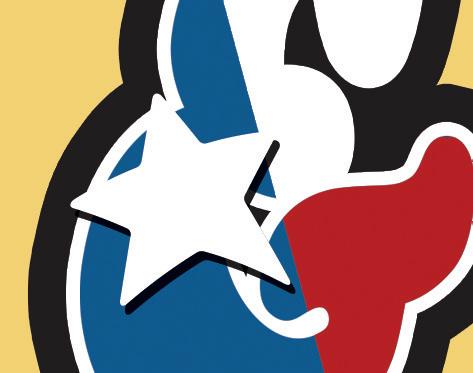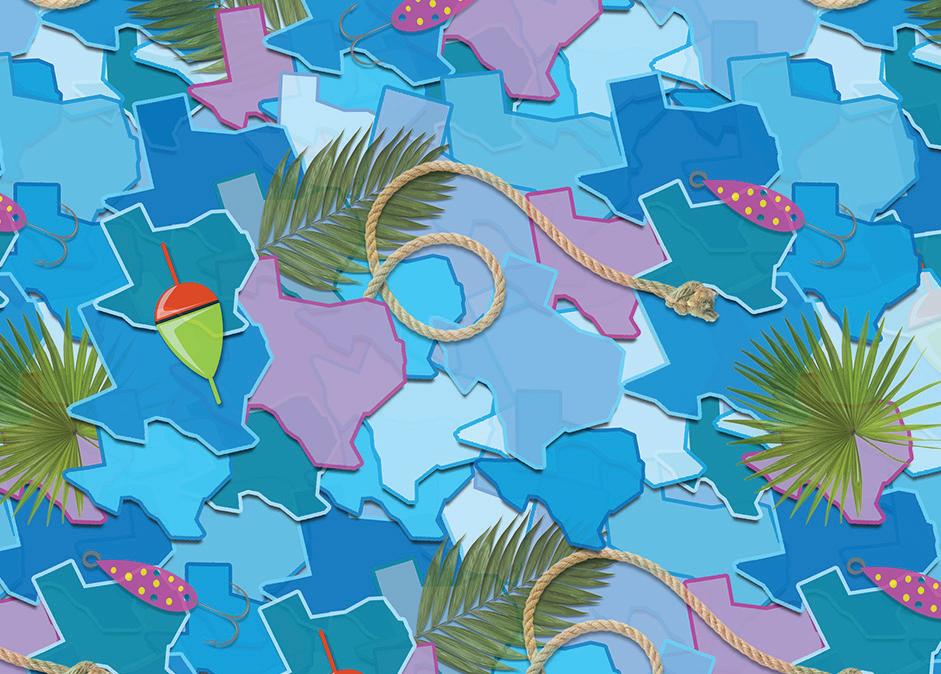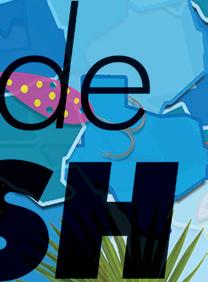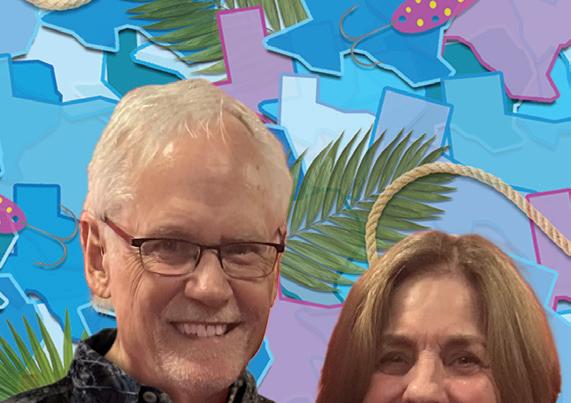
8 minute read
WDB: A Crusty Cuss, and the Spirit of Fish & Game A

S WE ZIP THROUGH THE calendar toward our 40th Anniversary issue next May, we felt it appropriate to revisit some of the highlights of Texas Fish & Game’s history. at history would not be complete... wait, correct that... would not have happened at all ...without the spirited vision of one person.


William Douglas Bray, who signed every wri en form of communication he composed—le er, memo, contract, greeting card, post-it note—with the initials “WDB,” was the iconoclastic owner of e Highland Publishing Company, in Marble Falls, Texas, at the time Texas Fish & Game came into being.
In the late 1960s, Bill Bray became a dominating force in the Marble Falls community and throughout the region of Burnet and Llano Counties, the area known as e Highland Lakes. Its ve major freshwater lakes—Buchanan, Inks, LBJ, Marble Falls, and Travis—at the gateway to the Texas Hill Country, had already made it an a ractive outdoors and recreation destination for visitors from all over Texas and beyond.
In the summer of 1968, Bill was a recent graduate of the University of Houston Law School, with an undergraduate degree in accounting from the University of Texas. He and his rst wife, Donna, relocated to Marble Falls to stay brie y with Bill’s parents, Bob and Bea Bray. e elder Brays operated a local weekly newspaper, e Highlander. Bill’s parents were career newspaper editors and publishers, having run weeklies and dailies all over the state, including stints in the Rio Grande Valley, Austin and Brady, where Bill was born.
ey landed in Marble Falls in 1959 and purchased the then one-year-old Highlander e paper struggled, being the smallest of three newspapers covering Burnet County.
Bill showed up at a critical time in the history of Marble Falls and the Highland Lakes.
e area had bene ted from its proximity to the Lyndon B. Johnson ranch y miles away at Stonewall, and LBJ’s ownership of property adjacent to what would become his namesake lake. During his time in congress and the presidency, Johnson and his local cronies pushed the construction of state highways and ranch roads throughout the area, to accommodate their own personal and investment needs. eir public purse-dipping not only paid o for them, but also opened the gates of prosperity for the whole area. Residential and resort developments sprang up around the lakes. e largest, Horseshoe Bay, broke ground in 1968.
Despite the area’s economic boom, Bob and Bea’s li le weekly paper just couldn’t cash in.

at’s when Bill arrived, planning to spend the summer months in relative seclusion to study for the state bar exam and then move on to a career in the law. But his parents’ nancial crisis interrupted those plans.

Possessing raw intelligence, multiple degrees in higher education, and a personality that combined the charisma of a country politician with the persistence of a time share salesman, Bill couldn’t resist barreling his way into e Highlander’s balance sheet woes.
He convinced the local bank that under his guidance, and through a series of bank nanced real estate deals and retail development, he could not only li e Highlander’s fortunes, but also li those of the whole community even higher.


He bought acreage along RR 1431 in Marble Falls (a four-lane thoroughfare, unique for state ranch roads of the time... one of Johnson’s gi s to the region) and, with the bank’s backing, built a Gibson’s Discount Center on one of the prime parcels. A forerunner of Walmart, Gibson’s stores were staples of small towns across Texas. e store’s advertising in e Highlander—underwri en by savvy exploitation of co-operative ad reimbursement allowances provided by the hundreds of products on the store’s shelves—helped save the paper from extinction, and funded a growth strategy that within a few years built e Highlander into the largest weekly in Texas.
Bray opened satellite o ces, one in Burnet and one in Llano County, and sta ed up to provide serious coverage of both counties. He recognized that the 1,800 square mile region straddling the Highland Lakes chain could be exploited as a single market, much greater than the three separate small towns alone. e investment paid o . Pages of ads owed into the paper from businesses in both counties, especially those in the booming real estate market around the lakes.
When we arrived on the scene (Roy in 1978 and Ardia in 1981) much of Bray’s impact was well established. He was just 35 in 1978, but he had rmly cemented his place as a prominent xture in the region’s economic, political and business circles. While many key gures of the time—bank management, the developers of Horseshoe Bay and the area’s top real estate players—held him in high esteem, a large contingent of other business and political big shots did not, especially those whose power was ensconced in the county seat cities of Burnet and Llano.
Part of it was Bray’s brash, confrontational personality and his talent for weaving X-rated language into even the most casual of conversations (his creative use of the F word was almost an art form). But most of the scorn he earned came from Bray’s vision and execution of the tone and depth of news coverage in e Highlander.
Small town big shots do not generally like having their actions followed and questioned, and back in the days before the Internet and social media, that trait was especially pronounced. And it was certainly prevalent among the movers, shakers and advantage takers running things around the Highland Lakes.
Weekly newspapers of that period were generally sta ed by an Editor/Publisher, one maybe two full-time reporters, a kid helping cover high school sports, and a gaggle of busy bodies reporting on the local social scene. e Highlander sta was more like a mid-size daily. Full-time editors were stationed in the satellite o ces in Burnet and Llano Counties. e main o ce on Main Street in Marble Falls was a bustling hive of journalism. Bray hired serious journalists and let them do their thing. Whereas the competition played the “good news” game with city councils, commissioners courts, school boards and other public and industrial institutions, e Highlander told it like it was. is did not sit well with the local power brokers, but the public bought in and kept the circulation of e Highlander strong. Businesses, many of which were the day-jobs of the power brokers, had to grit their teeth and support this bane of their existence as the best way to keep customers coming through their doors.
Awash in success, but not one to rest on his accomplishments, Bray set out with a plan to create the world’s largest supermarket... in Marble Falls. He cajoled a local independent grocer into a partnership that would merge Gibson’s and the supermarket into one huge store. Lakeland Mall opened in 1982, a 40,000 square foot giant, selling everything from sporting goods to fresh produce. At a time when 18,000 sq. . was the norm, it predated the superstore concept adopted by Walmart and Target by at least a decade.
Such was the vision of William Douglas Bray. When Texas Fish & Game came along, the WDB spirit eventually crept into that project as well. Growing out of a quarterly section of e Highlander, it started as e Highland Lakes Sportsman. ose of us who ran the newspaper for Bray were all avid anglers and hunters—a er all, we lived around the largest chain of freshwater lakes in the state, and near Llano, the self-proclaimed Deer Capital of Texas—and so this special section garnered even greater special a ention than the other “special” sections the newspaper lived o of.
Our interest eventually led us to break it out as a standalone publication, rst as a regional tabloid for the Highland Lakes area. Before long, we got the itch to take it statewide.
By that time, Bray had relinquished all day to day publishing duties to his crack management team at e Highlander, which included the president of the publishing company, Dan Alvey, and the two of us, Roy as publisher and Ardia as ad director of the newspaper.
To go statewide, however, we needed major capital, so we rolled out our big gun... William Douglas Bray.
In those days, magazines were still thriving enterprises with great potential, and new titles were popping up everywhere. Newsstands were huge and were everywhere, from corner stores to airports, and mailboxes were stu ed with colorful weekly and monthly editions.
But unlike the anarchy of today’s media world where any kid with a smart phone and smart-ass personality can become an overnight social media mogul with millions of followers, back then the barriers to starting a new publishing venture were high. High, but more straightforward in what it took to succeed—a lot more than in today’s ckle randomness of what goes viral and what doesn’t. It took a clear editorial mission, a bit of marketing savvy, and money. We had the rst two of those requirements—plus the advantage of being almost literally in the heart of the Texas outdoors, one of the strongest shing and hunting markets in the nation.
All we needed was a lot of cash to get the ball rolling. When Bray saw what we were trying to do, he jumped in with his typical over the top zeal.
To a ract subscribers, we had to create and mail elaborate direct mail packages—o cially known in the industry as “junk mail”—to prospects. ese promotions included slick brochures, personalized le ers, colorful reply cards and postage-paid return envelopes... a lot of design work and production expense. We had the built-in design talent, but had to outsource the printing and mailing.
We also had to procure the lists of prospective names... rented from other outdoor publications and catalogs, at a he y rate.
At the time, a successful direct mail campaign meant ge ing anything over two percent response. Our rst e orts, because we were seeding relatively un-tilled land, generated almost ve percent. is was a home run, and the rst year e ort took our circulation from nearly zero to 20,000. But that meant we had to reach out to half a million prospects... at a cost of a quarter million dollars! Bray did it without blinking, and we never looked back. e newsstand business in those days was a lot like the construction business in New York and New Jersey, but without the “enforcers” and tomato sauce. Territories were rmly established and if publishers wanted space on a crowded newsstand, they had to play by xed rules, and pay all sorts of “allowances” to keep anything “unfortunate” from happening to live copies on display. ankfully, enough of his spirit had been ingrained in us that, despite all the challenges we’ve faced, Texas Fish & Game survives.
We also had to establish the newly christened Texas Fish & Game on newsstands across the state (we couldn’t upgrade Highland Lakes Sportsman to Texas Sportsman because another magazine already had that title).
Back in the mid-1980s, 20 newsstand distribution agencies “owned” the major markets in Texas. Now there is just one agency that covers the entire U.S. But back then, we had to travel to each of those agencies and convince them to accept our new publication.
Given these lawless conditions and the natural rule of thumb that we should be thankful to sell 25% of the copies we put out, newsstands were a losing business. But publishing in those heady days was all about ad revenues, and so the losses—just like the losses incurred building subscriptions—were just part of the price of admission to the magazine game that we wanted to play.
William Douglas Bray, in those meetings with the twenty “families” controlling Texas newsstands was a priceless experience. In addition to his profane brashness, he had a West Texas drawl so thick it made any discussion with him sound like Slim Pickens giving a lecture on macro economics. Even though we won li le to nothing in the negotiation with these agencies, Bray’s performances made them earn every ill-go en cent they took out of our pockets.
Years later, in the mid-1990s when we bought Bill out and took over Fish & Game, we freed ourselves from the o en too-heavy burden of his personality and its negative e ects on both sta and clients. But we also lost a relentless ally in what became a bleak media war scape that awaited us in this new century.

Here’s to WDB, still one crusty cuss and the blankety-blankest of all blankety-blankers










